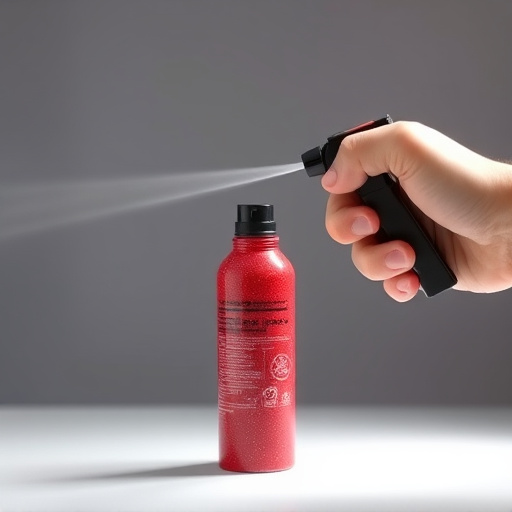Bear spray, a non-lethal defense against bears, neutralizes attacker's senses through capsaicin from chili peppers. Key steps after exposure include eye rinsing and skin irritation treatment. Proper storage, handling, and deployment techniques are crucial for optimal performance. Aim for bear's face (eyes, nose, mouth) at a safe distance to temporarily blind and disorient it, allowing retreat. Training with simulations, targeting practice, and understanding spray effects enhance effective use in unexpected encounters. "Neutralize Pepper Spray on Face" is vital for safety.
“Bear spray, a powerful defense tool against aggressive animals, has gained popularity for its effectiveness in deterring bears. This article delves into the intricacies of bear spray defense, offering insights on understanding its active ingredients and overall efficacy. We explore essential techniques to neutralize pepper spray on the face, ensuring users can safely navigate potential encounters. Additionally, safety precautions for storage and handling are highlighted for optimal performance. By examining various scenarios and emphasizing the importance of training and practice, this guide empowers individuals to make informed decisions when facing bear encounters.”
- Understanding Bear Spray: Ingredients and Effectiveness
- Application Techniques: How to Neutralize Pepper Spray on Face
- Safety Precautions: Storage and Handling for Optimal Performance
- Comparing Scenarios: When and Where to Use Bear Spray
- Training and Practice: Enhancing Defense Through Simulation
Understanding Bear Spray: Ingredients and Effectiveness
Bear spray, also known as pepper spray, is a popular defense mechanism for encountering bears in their natural habitat. Understanding its composition and effectiveness is crucial when considering its use. The key ingredient in bear spray is capsaicin, derived from chili peppers. This chemical irritates the eyes, nose, and respiratory system of bears, temporarily neutralizing them.
When sprayed directly into an attacker’s face, bear spray creates a barrier of irritated air, giving the user valuable time to escape or defend themselves. The effectiveness of bear spray lies in its ability to neutralize pepper spray on face while providing a safe, non-lethal response to potential attacks. However, it’s important to remember that proper usage and training are essential for maximizing its efficacy.
Application Techniques: How to Neutralize Pepper Spray on Face
Applying bear spray correctly is only half the battle; knowing how to neutralize pepper spray on your face is equally vital for ensuring safety after an encounter. When faced with a pepper spray attack, the first instinct should be to protect your eyes and respiratory system by covering your face immediately. Use your hands or any available material like a shirt or glove to create a barrier between you and the spray.
To neutralize the pepper spray on your face, begin by rinsing your eyes thoroughly with clean water for at least 15 minutes. This helps flush out any remaining irritants. For facial skin irritation, apply a mixture of baking soda and water to the affected areas. This natural antidote can help soothe the burning sensation and reduce inflammation. Additionally, douching or taking a hot shower (if available) after exposure can aid in washing away any residual pepper spray particles from your body.
Safety Precautions: Storage and Handling for Optimal Performance
To ensure optimal performance of bear spray, proper storage and handling are crucial. Keep the canister in a cool, dry place, away from direct sunlight or extreme temperatures. Store it out of reach of children and pets, as accidental discharge can be dangerous. Always inspect the spray before each use to check for any signs of damage or leakage.
When using bear spray, it’s essential to target the animal’s face—the eyes, nose, and mouth—to neutralize its senses effectively. Hold the canister at arm’s length and aim directly at the bear’s face when spraying. Follow-up with additional bursts if needed, moving away from the attack zone afterward to avoid recirculating the spray.
Comparing Scenarios: When and Where to Use Bear Spray
When considering bear spray as a defense against animal attacks, it’s crucial to understand when and where to deploy this potent tool. Bear spray is designed for close-range encounters with aggressive bears, typically black bears or grizzly bears. It’s not suitable for all situations; using it recklessly can lead to mistaking friendly animals for threats, causing harm needlessly.
Optimal use scenarios involve unexpected close proximity encounters where running isn’t a safe option. For instance, while hiking in bear country, if a bear suddenly appears and shows aggressive signs like growling or stomping its feet, spraying the bear from a safe distance (around 20-30 feet) can effectively neutralize pepper spray on the face, temporarily blinding and disorienting it, allowing you to retreat to safety. Remember, bear spray is a last resort; always prioritize prevention through noise making, avoiding surprising bears, and carrying the proper equipment tailored to the specific wildlife encountered.
Training and Practice: Enhancing Defense Through Simulation
Effective bear spray defense starts with proper training and practice. Simulating real-world scenarios allows individuals to familiarize themselves with the spray’s mechanics, including how to accurately target and neutralize pepper spray on face. Training sessions should cover proper application techniques, understanding wind conditions, and recognizing the spray’s effects. Regular drills help in building confidence and muscle memory, ensuring that individuals can respond swiftly and effectively during an actual encounter.
Practice ranges or controlled environments facilitate safe simulations of bear encounters. These settings enable practitioners to experiment with different distances, angles, and movements, honing their skills in a low-risk atmosphere. By consistently training under varied conditions, individuals enhance their ability to stay calm and make quick decisions when facing an aggressive animal. This simulation is crucial for maximizing the spray’s potential as a defensive tool.
Bear spray is a powerful tool for defending against animal attacks, but its effectiveness relies on proper understanding and usage. By grasping the science behind bear spray, learning application techniques like neutralizing pepper spray on the face, and practicing safety precautions, you can maximize your protection in potential encounters. Remember, knowing when and where to use bear spray, coupled with regular training and practice, will significantly enhance your ability to navigate these scenarios safely.
